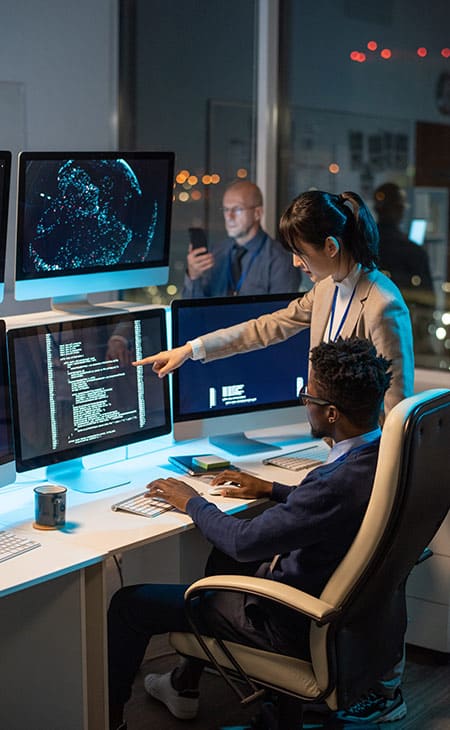Welcome, savvy readers, to a comprehensive exploration of the executive interview realm! In the dynamic landscape of top-tier talent acquisition, executive interviews stand as a pivotal gatekeeper to identifying leaders who can steer a company toward triumph. The journey of hiring executives is laden with challenges, and that’s precisely what makes it a riveting venture.
In this blog post, we unravel the intricacies of executive interviews and delve into the art of posing questions that truly unveil the potential of top-level candidates. Hiring executives isn’t just about qualifications; it’s about finding visionary leaders who align seamlessly with a company’s aspirations.
Here, we recognize the paramount importance of selecting the right questions—queries that go beyond the surface and dive deep into a candidate’s mindset, decision-making prowess, and strategic thinking. As we embark on this enlightening journey, you’ll discover over 100 thoughtfully curated executive interview questions, each designed to unravel the layers of an executive’s capabilities.
So, fasten your seatbelts as we navigate the crucial landscape of executive interviews, decoding the language of leadership and unearthing the traits that define exceptional executives. Let’s embark on this voyage together, exploring the questions that stand at the helm of hiring excellence. Ready to uncover the secrets? Let’s dive in!
Contents
- Chapter 1: The Basics of Interview Questions for Executives
- Chapter 2: General Executive Interview Questions
- Chapter 3: Role-Specific Executive Interview Questions
- Chapter 4: Decision-making & Problem-solving Executive Interview Questions
- Chapter 5: Team Management & Communication Executive Interview Questions
- Chapter 6: Industry-Specific Interview Questions for Executives
- Chapter 7: Leadership & Strategy Executive Interview Questions
- Chapter 8: Executive Interview Preparation Tips
- Conclusion
Chapter 1: The Basics of Interview Questions for Executives
Let’s dive into the essentials of interviewing executives. In this chapter, we’ll unravel the fundamental aspects that lay the groundwork for understanding the unique dynamics of executive interviews. From defining the role of an executive to exploring the diverse types and delving into the crucial qualities and skills, this chapter serves as your compass in navigating the intricate world of executive interviews.
What is an executive?
Ever wondered what sets an executive apart in the professional realm? An executive isn’t just a title; it’s a pivotal role in steering the ship of an organization. In a nutshell, an executive is a top-tier leader responsible for shaping strategies, making critical decisions, and orchestrating the overall vision of a company. They are the architects of success, sculpting the path toward organizational goals.
Executives operate at the helm, overseeing the big picture while strategically guiding their teams. Their influence extends beyond the day-to-day operations, impacting the trajectory of the entire company. These individuals are entrusted with not just managing but inspiring, not merely directing but envisioning.

So, what does this encompass? Executives often inhabit C-suite positions such as CEO, CFO, or COO, depending on their area of expertise. Their responsibilities transcend functional boundaries, requiring a holistic understanding of business dynamics.
Executives are visionaries, charting the course for the company’s future. They navigate through uncertainties, make tough decisions, and lead their teams with a strategic mindset. From setting financial goals to ensuring effective communication channels, executives are the linchpin of organizational success.
Understanding the essence of an executive is vital for both recruiters and candidates. It sets the stage for crafting insightful interview questions that go beyond the surface, tapping into the core competencies that drive executive excellence.
What are the Different Types of Executives?
Executives are not a one-size-fits-all category; they come in diverse roles, each with a unique set of responsibilities and focus. Understanding these nuances is key to tailoring interview questions that resonate with the specific demands of different executive positions.
Exploring C-suite Dynamics
At the zenith of the corporate hierarchy is the Chief Executive Officer (CEO). This visionary is the face of the company, steering it towards its overarching goals. On the other hand, the Chief Financial Officer (CFO) is the financial maestro, orchestrating fiscal strategies and ensuring the organization’s economic health. The Chief Operating Officer (COO) is the linchpin for seamless operations, overseeing day-to-day activities and implementing strategic plans.
Beyond the C-suite
However, executives extend beyond the traditional C-suite. Vice Presidents (VPs) hold pivotal roles in specific domains such as marketing, human resources, or technology. Their focus is narrower but equally critical, diving deep into functional areas to drive success. Directors, another cadre of executives, bridge the gap between strategic vision and operational execution, ensuring cohesion across various departments.
Strategic Leaders in Action
Executives aren’t confined to titles alone. Strategic leaders, for instance, might not bear a traditional executive title, but their influence is profound. These individuals are catalysts for change, steering organizations through innovation and adaptability. Their impact is felt across departments, fostering a culture of continuous improvement.
Industry-Specific Executives
In certain industries, specialized executives take the reins. For example, a Chief Technology Officer (CTO) in the tech sector brings technical prowess to the forefront, shaping the company’s technological trajectory. In healthcare, Chief Medical Officers (CMOs) lead with a deep understanding of medical practices, ensuring that organizational strategies align with the ever-evolving healthcare landscape.
The Evolving Landscape of Executives
As industries evolve, so do executive roles. The rise of Chief Diversity Officers (CDOs) reflects a growing emphasis on inclusivity and equality. These executives champion diversity initiatives, fostering a workplace where every voice is heard. The landscape of executives continues to shift, adapting to the dynamic demands of the modern business world.
Recognizing the multitude of executive roles is crucial for tailoring interview questions. Whether recruiting a CEO or a Director, comprehending the specific demands of each role ensures that the interview process is a strategic match, aligning organizational needs with executive expertise.
What are Executives’ Key Qualities and Skills?
Beyond titles and responsibilities, the essence of an executive lies in a unique blend of qualities and skills. To decipher the DNA of an effective executive, we must explore the traits that set them apart and the skills that propel them to leadership excellence.
Strategic Vision
Executives are visionaries, capable of seeing the big picture and plotting a course for the future. Their strategic vision extends beyond the immediate horizon, allowing them to navigate uncertainties and position the organization for sustained success. This foresight is not just about setting goals but about understanding the intricate connections between decisions and outcomes.
Decisiveness in Action
Decisions at the executive level carry significant weight. Executives must navigate through complex scenarios, often with incomplete information. The ability to make timely, well-informed decisions is a hallmark of effective leadership. Decisiveness is not just about making choices but about taking responsibility for their consequences.
Exceptional Communication Skills

Executives serve as communicators-in-chief for their organizations. From articulating a compelling vision to fostering transparent internal communication, their words carry weight. Effective executives excel in both verbal and written communication, ensuring that their messages resonate with diverse stakeholders.
Adaptability and Resilience
In the dynamic landscape of business, adaptability is non-negotiable. Executives must navigate change with resilience, embracing challenges as opportunities for growth. Their ability to pivot strategies in response to market shifts or internal dynamics distinguishes them as leaders who thrive in uncertainty.
Team Leadership and Empathy
Leading teams requires more than just strategic acumen. Executives must inspire and motivate diverse teams toward a common goal. This demands empathy and the ability to understand and connect with the individuals comprising the workforce. Exceptional executives foster a collaborative culture, recognizing that the team’s strength is integral to organizational success.
The qualities and skills outlined above are not mere checkboxes but a dynamic interplay that defines executive prowess. As we delve into interview questions, understanding these attributes provides a roadmap for evaluating candidates. It’s not just about finding someone with a title; it’s about identifying individuals whose qualities align with the organization’s values and whose skills elevate them as catalysts for success.
In this chapter, we unraveled the essence of executives, exploring their roles, types, and the key qualities that make them indispensable leaders. But hold on—there’s more to discover.
As you gear up for the next chapter, imagine peeling back the layers of general executive interview questions. We’ll delve into the queries that go beyond the surface, probing the minds of potential leaders. Get ready to uncover the strategies that recruiters employ to unearth the true potential of executive candidates.
Chapter 2: General Executive Interview Questions
In this chapter, we’ll explore the nuanced world of general executive interview questions. These probing inquiries go beyond resumes and dive deep into the core of a candidate’s experiences, motivations, and leadership style. By the end of this chapter, you’ll not only have a toolkit of questions but also a keen understanding of how to interpret responses and unearth the qualities that make an executive truly exceptional.
Tell me about yourself and your career path.
Sample Answer:
“Absolutely. I began my career in [industry], where I honed my skills in [key areas]. Over the years, I’ve navigated through roles such as [previous positions], accumulating valuable experience in strategic planning and team leadership. My journey has been marked by a commitment to [core values], and I’m excited to bring this wealth of experience to contribute to the success of [current company].”
Interpretation:
This question offers a holistic view of the candidate’s professional journey, allowing you to gauge their narrative and how well it aligns with the values and goals of your organization.
What are your greatest professional achievements, and how did you accomplish them?
Sample Answer:
“One of my standout achievements was [specific project], where I spearheaded a team that [achievement details]. It required a blend of strategic thinking and hands-on leadership. By fostering a collaborative environment and leveraging my strengths in [key skills], we not only met but exceeded our targets, earning accolades from both internal and external stakeholders.”
Interpretation:
This question provides insights into the candidate’s ability to set and achieve goals, showcasing their impact and the strategies they employed to drive success.
What are your strengths and weaknesses as a leader?
Sample Answer:
“My strength lies in [specific leadership quality], where I excel in [details]. On the flip side, I recognize that I can be overly meticulous at times, a trait I actively manage by balancing attention to detail with a focus on the bigger picture.”
Interpretation:
Understanding a candidate’s self-awareness regarding their leadership style and areas for improvement helps in assessing their potential for growth and adaptability.
What are your motivations for pursuing this particular executive role?
Sample Answer:
“I’ve been inspired by [aspects of the company], such as its commitment to [core values] and the innovative approach to [industry-specific aspect]. My skills align perfectly with the challenges this role presents, and I’m motivated to contribute my experience in [relevant areas] to drive the company’s growth and success.”
Interpretation:
This question gauges the candidate’s alignment with your organization’s values and the strategic fit between their aspirations and the company’s objectives.
How do you stay motivated and energized in your work?
Sample Answer:
“I stay motivated by continually setting new challenges for myself. Whether it’s exploring innovative solutions, fostering a positive team culture, or staying abreast of industry trends, I find that maintaining a dynamic and forward-thinking approach keeps me energized.”
Interpretation:
Understanding the sources of a candidate’s motivation provides insights into their work ethic and how well they align with the dynamic nature of executive roles.
Describe your leadership style and how you empower your team to achieve success.
Sample Answer:
“My leadership style revolves around fostering a collaborative and empowering environment. I believe in providing a clear vision and then empowering my team members to take ownership of their responsibilities. By promoting open communication, recognizing individual strengths, and fostering a culture of innovation, I create a space where everyone feels valued and motivated to contribute their best.”
Interpretation:
This question assesses not only the candidate’s awareness of their leadership style but also their approach to team empowerment. Look for indicators of inclusivity, communication skills, and the ability to inspire collective success.
How do you handle conflict within your team and foster a positive work environment?
Sample Answer:
“Conflict is inevitable, but I view it as an opportunity for growth. I address conflicts promptly by facilitating open dialogue, ensuring that each party feels heard. By focusing on solutions rather than blame, I guide the team towards resolution. Simultaneously, I create a positive work environment by promoting a culture of respect, recognition, and celebration of achievements.”

Interpretation:
This question delves into the candidate’s conflict resolution skills and their commitment to maintaining a positive work environment. Look for indications of emotional intelligence, diplomacy, and the ability to turn challenges into opportunities.
How do you motivate and inspire your team to achieve ambitious goals?
Sample Answer:
“I motivate my team by setting ambitious yet achievable goals that align with our overarching objectives. Recognition and regular communication of milestones keep the team energized. I lead by example, demonstrating commitment and enthusiasm. Additionally, I encourage a culture of continuous learning, ensuring everyone feels a sense of purpose in contributing to our collective success.”
Interpretation:
This question gauges the candidates’ motivational strategies and their ability to inspire a team toward ambitious objectives. Look for a blend of goal-setting, communication skills, and a commitment to fostering a positive team culture.
Share an example of a time when you had to make a tough decision and how you navigated it.
Sample Answer:
“In a previous role, I faced a challenging decision related to [specific scenario]. I gathered relevant data, consulted key stakeholders, and carefully considered the implications. While the decision was tough, I communicated transparently with the team, explaining the rationale and mitigating concerns. The experience reinforced the importance of decisiveness tempered with empathy and transparency.”
Interpretation:
This question probes the candidate’s decision-making process, resilience, and communication skills during challenging situations. Look for a balance between strategic thinking, empathy, and effective communication.
How do you delegate tasks effectively and ensure accountability among your team members?
Sample Answer:
“Delegating tasks involves a thorough understanding of each team member’s strengths. I assign responsibilities based on individual capabilities, providing clear expectations and timelines. Regular check-ins and a transparent communication channel ensure accountability. I foster a culture where each team member recognizes their impact on the collective goals, instilling a sense of ownership.”
Interpretation:
This question assesses the candidate’s delegation and accountability mechanisms. Look for indications of understanding team dynamics, effective communication, and a commitment to shared responsibilities.
Pro Tip
: Mastering Effective Delegation and Accountability
When discussing your approach to delegating tasks and ensuring accountability, consider highlighting a specific instance where your delegation strategy led to a successful outcome. Share a concise story that illustrates not only your understanding of each team member’s strengths but also how you tailored your communication to suit their working style.
Additionally, emphasize the importance of clear expectations and open communication channels. Describe how you set transparent timelines, conduct regular check-ins, and encourage team members to voice concerns or seek guidance. Showcase your commitment to fostering a collaborative culture where accountability is not a top-down imposition but a shared responsibility.
By providing a real-world example and detailing the key elements of your delegation and accountability framework, you not only answer the question effectively but also offer a tangible demonstration of your leadership style in action. Remember, practical examples resonate strongly in interviews and showcase your ability to translate leadership theories into successful outcomes.
How do you analyze complex business situations and identify growth opportunities?
Sample Answer:
“I approach complex situations by conducting a comprehensive analysis, considering market trends, competitive landscapes, and internal capabilities. This involves leveraging data analytics, seeking input from diverse perspectives, and fostering a culture of continuous learning. Identifying growth opportunities is not just about reacting but proactively anticipating market shifts and aligning them with the organization’s strengths.”
Interpretation:
This question assesses the candidate’s strategic thinking and analytical skills. Look for indications of data-driven decision-making, adaptability, and the ability to foresee opportunities in the midst of complexity.
Describe your vision for the future of this company and how you plan to achieve it.
Sample Answer:
“My vision for the company centers around [specific goals], emphasizing innovation, sustainability, and market leadership. To achieve this, I propose a strategic roadmap that involves [key initiatives]. This includes leveraging emerging technologies, fostering a culture of agility, and establishing strategic partnerships. The vision isn’t just about aspirations but a tangible plan that aligns with the company’s mission and values.”
Interpretation:
This question gauges the candidate’s ability to think forward, set visionary goals, and translate them into actionable plans. Look for clarity, alignment with company values, and a strategic roadmap that demonstrates feasibility.
How do you communicate your vision and strategic plans to stakeholders and ensure alignment across the organization?
Sample Answer:
“Communication is key in translating vision into reality. I employ a multi-faceted approach involving clear and compelling messaging, interactive town hall sessions, and personalized communication with key stakeholders. Additionally, I ensure alignment by fostering a participatory culture, soliciting feedback, and integrating insights into the strategic implementation process.”
Interpretation:
This question delves into the candidate’s communication skills and ability to create alignment. Look for a blend of effective messaging, stakeholder engagement, and mechanisms for incorporating diverse perspectives into the strategic narrative.
How do you adapt your strategies to changing market conditions and industry trends?
Sample Answer:
“Adaptability is crucial in the dynamic business landscape. I stay informed through continuous market research, maintain a pulse on industry trends, and foster a culture of flexibility within the team. Regular strategy reviews and scenario planning allow for swift adjustments, ensuring our strategies remain relevant and resilient in the face of evolving market conditions.”

Interpretation:
This question assesses the candidate’s agility and ability to navigate changing landscapes. Look for a commitment to staying informed, proactive adjustments to strategies, and a team-centric approach to adaptability.
Share an example of a time when you successfully implemented a strategic initiative that led to significant growth or improvement.
Sample Answer:
“In a previous role, I spearheaded a strategic initiative that involved [specific details]. Through meticulous planning, cross-functional collaboration, and a focus on innovation, we not only achieved our growth targets but exceeded them by [percentage]. This success resulted from aligning the initiative with our organizational strengths and leveraging market opportunities effectively.”
Interpretation:
This question provides a tangible example of the candidate’s ability to translate strategic vision into impactful results. Look for a narrative that highlights planning, collaboration, and the tangible outcomes of the implemented initiative.
What are your key insights into the current state of our industry and its future outlook?
Sample Answer:
“My insights into the current state of the industry stem from a continuous analysis of market trends, competitor landscapes, and customer behaviors. I’ve observed [specific observations] indicating [industry trends]. Looking ahead, I foresee [future outlook] and propose strategies to leverage emerging opportunities and mitigate potential challenges.”
Interpretation:
This question assesses the candidate’s industry knowledge and foresight. Look for evidence of ongoing industry analysis, awareness of current trends, and a forward-thinking approach to the industry’s future.
What are the major challenges and opportunities facing our industry, and how do you plan to address them?
Sample Answer:
“The industry faces challenges such as [specific challenges], but these are coupled with exciting opportunities like [opportunities]. To address challenges, I propose [strategies], leveraging our strengths in [key areas]. Simultaneously, I plan to seize opportunities by [strategies], ensuring our proactive stance in navigating the industry’s landscape.”
Interpretation:
This question evaluates the candidate’s strategic thinking and problem-solving skills. Look for a comprehensive understanding of industry challenges and opportunities, coupled with actionable strategies for addressing them.
How do you stay informed about emerging trends and innovations in our industry?
Sample Answer:
“Staying informed is a continuous effort. I engage with industry publications, participate in relevant conferences, and maintain a network of industry professionals. Additionally, I foster a culture of curiosity within my team, encouraging them to share insights and participate in continuous learning. This collaborative approach ensures that we remain at the forefront of emerging trends and innovations.”
Interpretation:
This question assesses the candidate’s commitment to staying informed and fostering a culture of learning. Look for a mix of personal engagement, team collaboration, and external sources of industry insights.
How do you assess our company’s competitive position within the industry and identify areas for differentiation?
Sample Answer:
“I conduct a comprehensive competitive analysis, evaluating our strengths, weaknesses, opportunities, and threats. This involves benchmarking against industry leaders, customer feedback analysis, and assessing our unique value proposition. Identifying areas for differentiation requires a deep understanding of market demands, customer expectations, and aligning our strengths with unmet needs.”
Interpretation:
This question evaluates the candidate’s analytical skills and strategic assessment abilities. Look for evidence of a structured competitive analysis and a nuanced approach to differentiating the company within the industry.
Share an example of a time when you successfully identified a new market opportunity and capitalized on it.
Sample Answer:
“In a previous role, I identified a gap in the market related to [specific opportunity]. By conducting market research and collaborating with cross-functional teams, we developed [innovative solution]. This not only addressed an unmet customer need but also led to a [percentage] increase in market share, showcasing the successful capitalization of a new market opportunity.”
Interpretation:
This question provides insight into the candidate’s ability to identify and capitalize on market opportunities. Look for a strategic approach, collaboration, and tangible results stemming from the implemented initiative.
With a comprehensive exploration of general executive interview questions, we’ve journeyed through the landscape of strategic leadership, industry insights, and the ability to navigate challenges and opportunities.
Next, the stage is set to unravel the intricacies of how executives tailor their skills to specific roles, offering a deeper understanding of their unique contributions. Brace yourself for role-specific inquiries that illuminate the nuanced expertise and strategic visions that set executives apart in their domains.
The story of executive excellence continues, so without further ado, let’s venture forth into the realm of role-specific insights.
Chapter 3: Role-Specific Executive Interview Questions
In this chapter, we’ll uncover the distinctive perspectives and strategies of key executive roles: CEO, CFO, COO, CTO, and CMO. Each role carries its unique set of challenges and responsibilities that shape the trajectory of an organization.

CEO
At the organization’s helm, the CEO orchestrates the grand symphony of vision, strategy, and leadership. In the following questions, we unravel the intricacies of a CEO’s journey—from shaping the company-wide vision to steering through crises with resilience.
Describe your experience in developing and executing a company-wide vision and strategy.
Sample Answer:
“In my role as CEO at [previous company], I led the development and execution of a visionary strategy centered around [specific goals]. This involved aligning the entire organization with a cohesive vision, ensuring each team understood its role in achieving our long-term objectives.”
Interpretation:
This question assesses the candidate’s strategic thinking, communication skills, and ability to align organizational efforts toward a common vision.
How do you foster a culture of innovation and risk-taking within the organization?
Sample Answer:
“I foster innovation by encouraging an open exchange of ideas, rewarding calculated risks, and creating a safe space for experimentation. This approach not only fuels creativity but also instills a sense of ownership among employees, empowering them to contribute to the organization’s growth.”
Interpretation:
This question gauges the candidate’s leadership style, commitment to innovation, and ability to cultivate a dynamic organizational culture.
How do you attract, retain, and develop top talent in a competitive market?
Sample Answer:
“Attracting top talent involves showcasing our unique organizational culture and offering growth opportunities. Retention is achieved through mentorship programs and continuous skill development. By investing in our employees, we not only retain talent but also create a workforce that evolves with the company.”
Interpretation:
This question assesses the candidate’s approach to talent management, employee development, and strategies for maintaining a competitive edge in talent acquisition.
How do you balance short-term financial goals with long-term strategic objectives?
Sample Answer:
“Balancing short-term and long-term goals requires a keen understanding of the business landscape. I prioritize short-term financial stability to support strategic initiatives. It involves aligning financial decisions with our long-term vision, ensuring that each tactical move contributes to the broader strategic journey.”
Interpretation:
This question evaluates the candidate’s financial acumen and the ability to synchronize short-term financial decisions with the organization’s long-term vision.
Share an example of a time when you successfully navigated a major crisis or challenge as CEO.
Sample Answer:
“In a challenging market downturn, we faced [specific crisis]. Through transparent communication, swift decision-making, and a collaborative approach, we not only weathered the storm but emerged stronger. This experience reinforced the importance of resilience, adaptability, and unwavering leadership during turbulent times.”
Interpretation:
This question provides insight into the candidate’s crisis management skills, resilience, and ability to lead effectively during challenging periods.
CFO
In the intricate dance of organizational success, the Chief Financial Officer (CFO) assumes the role of the financial maestro. This section delves into the strategic mindset of a CFO, exploring their approach to financial planning, transparency, stakeholder balancing, and the impactful decisions that shape the company’s financial trajectory.
Explain your approach to financial planning, forecasting, and risk management.
Sample Answer:
“My approach begins with a meticulous analysis of historical data, market trends, and internal capabilities. I collaborate closely with cross-functional teams to develop comprehensive financial plans and forecasts. Risk management involves identifying potential threats and implementing mitigation strategies, ensuring our financial path aligns with our organizational objectives.”
Interpretation:
This question assesses the candidate’s financial acumen, collaboration skills, and ability to navigate uncertainties through effective risk management.
How do you ensure financial transparency and accountability within the organization?
Sample Answer:
“Transparency is fundamental. I implement robust reporting mechanisms that provide clear insights into our financial health. Accountability is fostered through regular audits, clear communication of financial policies, and training programs to ensure all stakeholders understand their roles in maintaining financial integrity.”
Interpretation:
This question evaluates the candidate’s commitment to transparency, communication skills, and methods for instilling a sense of responsibility across the organization.
How do you manage capital allocation and investment decisions to optimize financial performance?
Sample Answer:

“I adopt a data-driven approach to capital allocation, weighing potential returns against risks. Investment decisions are aligned with our strategic goals, ensuring that every financial move contributes to long-term value. Regular performance assessments and feedback loops enable us to optimize our financial resources for maximum impact.”
Interpretation:
This question assesses the candidate’s strategic thinking, financial analysis skills, and ability to align financial decisions with the organization’s overarching goals.
How do you balance the needs of various stakeholders, including shareholders, employees, and customers, in financial decision-making?
Sample Answer:
“Balancing stakeholder needs is a delicate act. I prioritize transparent communication with shareholders, aligning financial decisions with their expectations. For employees, I ensure that financial strategies support growth and job security. Customers benefit from our financial decisions through competitive pricing and quality service.”
Interpretation:
This question gauges the candidate’s stakeholder management skills, communication abilities, and approach to integrating diverse perspectives into financial decision-making.
Share an example of a time when you implemented a financial strategy that led to significant improvement in the company’s financial position.
Sample Answer:
“In a period of market volatility, I implemented a cost optimization strategy that streamlined operational processes and identified inefficiencies. This resulted in a [percentage] reduction in operating costs and a subsequent boost in profit margins. The strategy not only strengthened our financial position but also positioned us for sustained growth.”
Interpretation:
This question provides insight into the candidate’s ability to translate financial strategies into tangible outcomes, showcasing their impact on the company’s financial health.
COO
In the orchestration of organizational success, the Chief Operating Officer (COO) takes center stage, steering the ship through the currents of operational efficiency and innovation. This segment unravels the strategic mindset of a COO, exploring their prowess in optimizing processes, managing risks, harnessing technology, and transforming operations for lasting impact.
Describe your experience in managing and optimizing operational processes for efficiency and effectiveness.
Sample Answer:
“My experience is anchored in the continuous pursuit of operational excellence. I analyze existing processes, identifying bottlenecks and inefficiencies. Through strategic streamlining and the implementation of best practices, I aim to enhance efficiency and overall effectiveness, ensuring each operational facet aligns with our organizational goals.”
Interpretation:
This question assesses the candidate’s operational management skills, analytical abilities, and their commitment to refining processes for optimal performance.
How do you ensure supply chain resilience and mitigate operational risks?
Sample Answer:
“Supply chain resilience is achieved through diversification, contingency planning, and robust risk mitigation strategies. I conduct thorough risk assessments, implement redundancies where necessary, and foster strong relationships with suppliers. This ensures a resilient supply chain capable of navigating unexpected challenges.”
Interpretation:
This question evaluates the candidate’s risk management skills, supply chain expertise, and approach to building resilience within the operational framework.
How do you leverage technology to enhance operational efficiency and drive innovation?
Sample Answer:
“Technology is a powerful ally in driving operational excellence. I leverage automation, data analytics, and emerging technologies to streamline processes, reduce manual interventions, and enhance overall efficiency. Innovation is embedded in our operational DNA, with technology serving as a catalyst for continuous improvement.”
Interpretation:
This question gauges the candidate’s technological acumen, innovation mindset, and ability to integrate technology seamlessly into operational strategies.
How do you measure and improve operational performance across various business units?
Sample Answer:
“I establish key performance indicators (KPIs) tailored to each business unit’s objectives. Regular assessments against these KPIs provide insights into operational performance. Continuous feedback loops, coupled with a culture of performance improvement, enable us to refine processes, address challenges, and elevate operational outcomes.”
Interpretation:
This question assesses the candidate’s measurement and improvement methodologies, emphasizing their commitment to ongoing performance enhancement across diverse business units.
Share an example of a time when you successfully transformed a company’s operations, leading to significant cost savings or revenue growth.
Sample Answer:
“In a previous role, I spearheaded an operational transformation initiative that involved [specific details]. This resulted in a [percentage] reduction in operational costs and a subsequent [percentage] increase in revenue. The transformation not only optimized our internal processes but also positioned the company for sustainable growth in a competitive market.”
Interpretation:
This question provides insight into the candidate’s ability to drive transformative change, showcasing their impact on both cost efficiency and revenue generation through operational enhancements.
CTO

In the dynamic landscape of technological evolution, the Chief Technology Officer (CTO) assumes a pivotal role as the architect of innovation and strategic technology advancement. This section unravels the strategic mindset of a CTO, exploring their approach to technology strategy, alignment with business goals, cybersecurity management, and the cultivation of a culture defined by technological agility and adaptability.
Explain your approach to technology strategy and innovation in a rapidly evolving digital landscape.
Sample Answer:
“My approach is rooted in continuous adaptation to the ever-evolving digital landscape. I foster an innovation mindset by encouraging cross-functional collaboration, investing in emerging technologies, and staying abreast of industry trends. Our technology strategy aligns with business goals, ensuring that every technological initiative contributes to the overall success of the organization.”
Interpretation:
This question assesses the candidate’s commitment to innovation, adaptability, and strategic approach to integrating technology with the broader goals of the company.
How do you align technology investments with the company’s overall business goals?
Sample Answer:
“Alignment is paramount. I work closely with leadership to understand business priorities and identify areas where technology can drive value. Investments are strategically directed towards initiatives that enhance efficiency, support growth, and align with the long-term vision. Regular assessments ensure that technology investments remain in sync with evolving business goals.”
Interpretation:
This question evaluates the candidate’s strategic thinking, collaboration skills, and ability to ensure that technology investments contribute to the company’s overarching objectives.
How do you manage cybersecurity risks and protect the company’s data and systems?
Sample Answer:
“Cybersecurity is a top priority. I implement robust security measures, conduct regular risk assessments, and ensure compliance with industry standards. Employee training and awareness programs contribute to a culture of vigilance. In the event of a threat, a swift response and recovery plan are in place to safeguard our data and systems.”
Interpretation:
This question assesses the candidate’s cybersecurity expertise, risk management skills, and approach to instilling a cybersecurity-conscious culture within the organization.
How do you foster a culture of technological agility and adaptability within the organization?
Sample Answer:
“I foster agility through continuous learning initiatives, cross-functional training, and promoting a culture that embraces experimentation. We encourage our teams to adapt quickly to emerging technologies, iterate on solutions, and learn from failures. This fosters a resilient and adaptable technological ecosystem within the organization.”
Interpretation:
This question gauges the candidate’s leadership style, commitment to fostering a culture of adaptability, and approach to cultivating a technologically agile workforce.
Share an example of a time when you successfully implemented a technology solution that transformed the company’s competitive advantage.
Sample Answer:
“In a previous role, I led the implementation of [specific technology solution]. This not only streamlined our internal processes but also positioned us as an industry leader by enhancing customer experiences and operational efficiency. The technology solution became a cornerstone of our competitive advantage, driving growth and market recognition.”
Interpretation:
This question provides insight into the candidate’s ability to translate technological initiatives into tangible competitive advantages, showcasing their impact on the company’s positioning within the market.
CMO
In the dynamic world of business, the Chief Marketing Officer (CMO) stands as the maestro of brand building, customer engagement, and sales growth. This section delves into the strategic mindset of a CMO, exploring their experience in developing comprehensive marketing strategies, leveraging data, cultivating customer relationships, adapting to trends, and orchestrating impactful campaigns.
Describe your experience in developing and executing a comprehensive marketing strategy that drives brand awareness, customer acquisition, and sales growth.
Sample Answer:
“My experience is centered on crafting holistic marketing strategies that align with organizational goals. By integrating brand-building initiatives, targeted customer acquisition campaigns, and sales-focused strategies, I aim to create a seamless customer journey. The success lies in ensuring that each aspect of the strategy contributes to brand awareness and drives meaningful sales growth.”
Interpretation:
This question assesses the candidate’s strategic marketing capabilities, integration of brand awareness with customer acquisition, and the ability to drive sales through comprehensive strategies.
How do you leverage data and analytics to inform marketing decisions and measure campaign effectiveness?
Sample Answer:
“Data is the cornerstone of effective marketing. I leverage analytics to gain insights into customer behavior, preferences, and campaign performance. This data-driven approach guides decision-making, enabling us to optimize campaigns in real time. By setting and analyzing key performance indicators, we ensure that each campaign aligns with our objectives and delivers measurable results.”
Interpretation:
This question evaluates the candidate’s proficiency in data-driven decision-making, analytics utilization, and their commitment to measuring and optimizing campaign effectiveness.
How do you build and maintain strong relationships with customers across various channels?
Sample Answer:
“Building relationships is about understanding our customers deeply. I employ a multichannel approach, utilizing social media, email marketing, and personalized interactions. By consistently delivering value, listening to customer feedback, and adapting our communication to individual preferences, we foster lasting connections that go beyond transactions.”

Interpretation:
This question gauges the candidate’s customer relationship management skills, multichannel approach, and dedication to personalized and value-driven interactions.
How do you adapt marketing strategies to emerging consumer trends and changing market dynamics?
Sample Answer:
“Adaptability is key in the fast-paced world of marketing. I stay ahead of trends through continuous market analysis, consumer behavior studies, and monitoring emerging technologies. By incorporating agile methodologies and maintaining a flexible strategy, we can pivot swiftly to align with evolving consumer trends and market dynamics.”
Interpretation:
This question assesses the candidate’s adaptability, trend analysis capabilities, and approach to ensuring marketing strategies remain relevant in a dynamic landscape.
Share an example of a time when you successfully launched a marketing campaign that led to a significant increase in brand recognition or customer engagement.
Sample Answer:
“In a previous role, we launched a [specific campaign] that resonated deeply with our target audience. Through meticulous planning, captivating storytelling, and leveraging multiple channels, the campaign not only elevated brand recognition but also resulted in a [percentage] increase in customer engagement. The success lay in understanding our audience and delivering a message that truly resonated.”
Interpretation:
This question provides insight into the candidate’s ability to translate creative concepts into successful campaigns, showcasing their impact on brand recognition and customer engagement.
So far, we’ve delved into the orchestration of comprehensive marketing strategies, the dance with data and analytics, the finesse of customer relationship building, adaptability in dynamic markets, and the impactful crescendo of successful campaigns. The symphony of marketing mastery echoes, emphasizing the executive’s role as a maestro in shaping brand narratives and customer experiences.
Yet, the crescendo does not fade; it echoes into the final chapter of our journey. In the upcoming segment, we’ll uncover the essential keys to success in executive interviews. Stay tuned as we unveil exclusive insights into problem-solving and decision-making executive interview questions.
Chapter 4: Decision-making & Problem-solving Executive Interview Questions
In this chapter, we’ll unravel the artistry behind the critical moments when leaders are called upon to navigate complexities, uncertainties, and ethical dilemmas. Each question provides a window into the decision-making prowess of executives and their problem-solving acumen. Let’s embark on a journey that explores the strategic minds of leaders as they share insights into their decision-making experiences and problem-solving triumphs.
Describe a time when you had to make a complex decision with incomplete or ambiguous information. How did you handle the uncertainty, and what was the outcome?
Sample Answer:
“In a scenario where critical information was missing, I adopted a phased decision-making approach. I gathered available data, consulted experts, and implemented contingency plans. The outcome showcased our ability to adapt, leading to [specific positive outcome], despite the initial uncertainty.”
Interpretation:
This question assesses the candidate’s adaptability, strategic thinking, and ability to make informed decisions with limited information.
Tell me about a decision you made that didn’t result in the desired outcome. How did you reflect on and learn from the experience?
Sample Answer:
“I made a decision that didn’t meet expectations, and it became a learning opportunity. I conducted a thorough post-mortem analysis, identified areas for improvement, and implemented corrective measures. This experience reinforced the importance of [specific lesson], shaping my approach to subsequent decisions.”
Interpretation:
This question evaluates the candidate’s reflection and learning process, showcasing their ability to glean insights from less-than-ideal outcomes.
Describe a situation where you faced an ethical dilemma while making a decision. How did you resolve it, and what principles guided your decision?
Sample Answer:
“Faced with an ethical dilemma, I anchored my decision in our organizational values and ethical principles. I engaged stakeholders, sought diverse perspectives, and arrived at a decision aligned with our core values. The resolution not only preserved integrity but strengthened our ethical foundation.”
Interpretation:
This question assesses the candidate’s commitment to ethical decision-making, stakeholder engagement, and adherence to organizational values.
Can you share an example of a time when you had to consider the long-term impact of your decision? How did you ensure the decision aligned with future goals and objectives?
Sample Answer:
“I navigated a decision by envisioning its long-term implications. I conducted a strategic analysis, aligned the decision with our future goals, and implemented measures to ensure sustained success. The foresight contributed to [specific positive outcome], validating the long-term alignment.”
Interpretation:
This question evaluates the candidate’s strategic thinking, foresight, and ability to align decisions with future organizational objectives.
Have you ever had to decide whether to delegate a decision or make it yourself? How did you determine the appropriate level of involvement, and what was the outcome?
Sample Answer:
“I faced a decision on delegation based on the complexity and urgency. I assessed team capabilities, aligned responsibilities with expertise, and set clear expectations. The outcome was a well-executed decision that leveraged team strengths, showcasing the power of strategic delegation.”
Interpretation:
This question assesses the candidate’s delegation skills, decision-making criteria, and ability to optimize team strengths.
How do you evaluate the potential risks and benefits before making a decision?
Sample Answer:
“Evaluating risks and benefits is a meticulous process. I conduct thorough risk assessments, considering both quantitative and qualitative factors. By engaging key stakeholders, I ensure a comprehensive view of potential outcomes. This systematic approach allows for informed decision-making that maximizes benefits while mitigating potential risks.”

Interpretation:
This question assesses the candidate’s risk assessment skills, stakeholder engagement, and ability to make informed decisions that balance risks and benefits.
Describe a situation where you had to weigh multiple options with conflicting priorities. How did you make a decision that balanced the competing factors?
Sample Answer:
“I navigated a scenario with conflicting priorities by establishing clear criteria. I conducted a comparative analysis, quantifying the impact of each option on our goals. Through strategic alignment and prioritization, I made a decision that addressed key objectives while acknowledging and mitigating conflicting priorities.”
Interpretation:
This question evaluates the candidate’s prioritization skills, strategic alignment, and ability to make decisions in complex situations with conflicting factors.
Can you share an example of a time when you had to use data and analytics to inform your decision-making process? How did you effectively interpret and apply the information?
Sample Answer:
“In a data-driven decision, I leveraged analytics to assess market trends and customer behavior. I interpreted the data to identify opportunities, quantify risks, and validate strategic choices. The outcome was a decision that not only aligned with data insights but also capitalized on emerging opportunities.”
Interpretation:
This question assesses the candidate’s proficiency in using data and analytics to inform decision-making, demonstrating their ability to translate insights into strategic choices.
Describe a situation where you had to consult with stakeholders or experts to gather additional information before making a decision. How did you manage this process and incorporate their input?
Sample Answer:
“I recognized the need for diverse perspectives in a decision, prompting me to consult with relevant stakeholders and experts. I facilitated open communication, gathered insights, and incorporated their input into the decision-making process. This collaborative approach resulted in a well-rounded decision with broad support.”
Interpretation:
This question evaluates the candidate’s collaboration skills, stakeholder management, and ability to incorporate diverse perspectives into decision-making.
How do you communicate your decision-making process to others, especially those who may disagree with your choice? How do you address their concerns and build consensus?
Sample Answer:
“Effective communication is key to garnering support for decisions. I provide transparent insights into the decision-making process, addressing concerns proactively. By fostering an open dialogue, I encourage constructive feedback and work towards consensus. This inclusive approach ensures that decisions are not only made but embraced by the team.”
Interpretation:
This question assesses the candidate’s communication skills, ability to address dissenting opinions and approach to building consensus within a team or organization.
Describe a time when you were faced with a significant problem at work. How did you approach the problem, and what steps did you take to resolve it?
Sample Answer:
“Confronted with a significant problem, I initiated a structured problem-solving approach. I first conducted a thorough analysis to understand the root causes. Collaborating with cross-functional teams, I devised a strategic plan, implemented solutions, and monitored outcomes. This comprehensive approach resulted in the successful resolution of the issue, contributing to improved efficiency and team morale.”
Interpretation:
This question assesses the candidate’s ability to approach and resolve significant workplace challenges through systematic analysis, collaboration, and strategic implementation.
Tell me about a situation where you had to identify the root cause of a complex problem. How did you systematically analyze the issue to uncover the underlying cause?
Sample Answer:
“Faced with a complex problem, I utilized a root cause analysis framework. I gathered data, conducted interviews, and applied analytical tools to identify contributing factors. By systematically peeling back layers, I pinpointed the root cause. Addressing this core issue led to a holistic solution that prevented future recurrences.”
Interpretation:
This question evaluates the candidate’s proficiency in root cause analysis, data-driven decision-making, and ability to uncover underlying issues in complex problems.
Can you share an example of a time when you had to generate creative solutions to a challenging problem? How did you approach the problem-solving process, and what innovative solutions did you develop?
Sample Answer:
“In a challenging scenario, I fostered a creative problem-solving environment. I encouraged team brainstorming sessions, embracing diverse perspectives. This collaborative approach led to innovative solutions such as [specific examples], transforming the problem into an opportunity for positive change.”
Interpretation:
This question assesses the candidate’s creativity in problem-solving, their ability to foster innovation within a team, and the successful implementation of creative solutions.
Describe a situation where you had to implement a solution that involved multiple stakeholders and departments. How did you manage communication, collaboration, and consensus-building to ensure successful implementation?
Sample Answer:
“Implementing a solution involving multiple stakeholders required a strategic approach. I established clear communication channels, facilitated collaborative sessions, and engaged stakeholders in the decision-making process. By addressing concerns, building consensus, and ensuring alignment with organizational objectives, the solution was successfully implemented, fostering a sense of ownership across departments.”
Interpretation:
This question evaluates the candidate’s skills in stakeholder management, communication, collaboration, and ability to build consensus for successful implementation.
Tell me about a time when you had to adapt your problem-solving approach due to unforeseen circumstances or changing priorities. How did you adjust your strategy and maintain momentum in addressing the problem?
Sample Answer:

“In the face of unforeseen circumstances, I embraced an adaptive problem-solving approach. I assessed the changes, adjusted the strategy, and maintained momentum by recalibrating timelines and resources. This flexibility ensured that the problem-solving efforts remained effective and aligned with evolving priorities.”
Interpretation:
This question assesses the candidate’s adaptability in problem-solving, ability to adjust strategies in dynamic situations, and ability to maintain progress toward solutions.
Describe a time when you had to prioritize multiple problems or issues simultaneously. How did you manage your time and resources to address them effectively?
Sample Answer:
“In a scenario with multiple simultaneous challenges, I employed a strategic approach to prioritize tasks. I conducted a thorough assessment of urgency and impact, allocated resources efficiently, and implemented a phased action plan. This systematic prioritization ensured that each problem received the attention required, leading to effective resolutions across the board.”
Interpretation:
This question assesses the candidate’s ability to prioritize tasks, allocate resources efficiently, and manage multiple challenges concurrently.
Tell me about a situation where you had to make a quick decision under pressure. How did you maintain composure and make a sound judgment?
Sample Answer:
“Under intense pressure, I faced a situation demanding a quick decision. I relied on my experience, maintained composure by staying focused on the goal, and swiftly assessed available information. This allowed me to make a sound judgment, demonstrating that decisiveness and composure are key elements even in high-pressure scenarios.”
Interpretation:
This question evaluates the candidate’s ability to make quick decisions under pressure while maintaining composure and ensuring sound judgment.
Can you share an example of a time when you had to overcome obstacles or resistance to implement a solution? How did you navigate challenges and achieve buy-in from stakeholders?
Sample Answer:
“In overcoming resistance to a proposed solution, I initiated open communication channels. I actively listened to concerns, addressed them transparently, and demonstrated the benefits of the proposed solution. By fostering collaboration and showcasing alignment with organizational objectives, I gained buy-in from stakeholders, paving the way for successful implementation.”
Interpretation:
This question assesses the candidate’s skills in overcoming obstacles, addressing resistance, and achieving stakeholder buy-in for effective solution implementation.
Describe a situation where you had to learn from past mistakes and apply that knowledge to future problem-solving. How did this continuous learning approach enhance your effectiveness?
Sample Answer:
“Reflecting on past mistakes, I embraced a continuous learning approach. I conducted post-mortem analyses, identified areas for improvement, and incorporated lessons learned into my problem-solving strategies. This iterative learning process enhanced my effectiveness by ensuring that each subsequent problem-solving effort benefited from prior experiences.”
Interpretation:
This question evaluates the candidate’s ability to learn from mistakes, apply lessons to future problem-solving, and enhance their overall effectiveness.
How do you balance the need to address immediate problems while also thinking strategically about the long-term implications of your solutions?
Sample Answer:
“Balancing immediate problem-solving with long-term strategic thinking involves a dual-focus approach. I prioritize immediate issues with a sense of urgency while concurrently considering the long-term implications. This ensures that short-term solutions align with overarching strategic goals, fostering sustainable success.”
Interpretation:
This question assesses the candidate’s ability to balance short-term problem-solving needs with long-term strategic thinking, ensuring that solutions contribute to overall organizational objectives.
As we conclude our journey through the intricacies of executive problem-solving, the path extends into the realm of Team Management and Communication in the next chapter. The dynamics of leading and communicating within a team is paramount for any executive. In this upcoming segment, we’ll delve into the nuances of fostering collaboration, inspiring teams, and navigating the intricate web of interpersonal dynamics.
The tapestry of executive acumen unfolds further, promising a deep dive into the realms of effective team leadership and communication strategies. Join us for the enlightening revelations that lie ahead as we explore the essential skills and insights required for executives to steer their teams toward success. The narrative of leadership prowess continues—stay engaged for the valuable insights that await in the chapters to come!
Chapter 5: Team Management & Communication Executive Interview Questions

In this chapter, we unravel the intricacies of building and leading teams to success. As an executive, mastering the art of fostering collaboration, motivating teams, and steering through challenges is pivotal. Get ready to delve into the strategies that define effective team management and communication in the executive landscape.
Describe your approach to building and leading high-performing teams.
Sample Answer:
“My approach centers on talent recognition, strategic alignment, and fostering a collaborative environment. By understanding individual strengths, I assemble a complementary team. Clear communication of goals and expectations ensures everyone is on the same page, driving the team towards high performance.”
Interpretation:
This question assesses the candidate’s strategy in assembling teams, ensuring alignment, and creating an environment conducive to high performance.
How do you foster a culture of collaboration and innovation within your team?
Sample Answer:
“I cultivate an open environment where ideas flow freely. Encouraging cross-functional collaboration and recognizing innovative efforts fosters a culture where each team member feels valued. This approach not only enhances creativity but also ensures a collaborative spirit.”
Interpretation:
This question evaluates the candidate’s ability to create an atmosphere conducive to collaboration and innovation, emphasizing the importance of a dynamic team culture.
How do you motivate and inspire your team members to achieve their best?
Sample Answer:
“Motivation stems from recognizing individual achievements and aligning them with the larger vision. I foster a supportive culture where each team member sees their impact. Regular feedback, coupled with growth opportunities, inspires them to excel and contribute their best.”
Interpretation:
This question assesses the candidate’s approach to motivation, recognizing individual contributions, and creating an environment that encourages excellence.
How do you handle conflict and resolve disagreements within your team?
Sample Answer:
“I address conflicts openly, promoting honest communication. Understanding each party’s perspective, I guide the team toward a resolution that aligns with our shared goals. This not only resolves immediate issues but also strengthens team dynamics.”
Interpretation:
This question evaluates the candidate’s conflict resolution skills, emphasizing open communication and aligning resolutions with team objectives.
How do you empower your team members to take ownership and make decisions?
Sample Answer:
“I empower team members by providing autonomy within defined boundaries. Encouraging them to take ownership fosters a sense of responsibility. This approach not only develops leadership skills but also ensures a proactive and engaged team.”
Interpretation:
This question assesses the candidate’s strategy in empowering team members, promoting autonomy, and nurturing a sense of responsibility.
Pro Tip
: Nurturing Empowerment for Team Success
When empowering team members to make decisions, consider implementing a mentorship approach. Pair less experienced team members with seasoned colleagues to guide them through decision-making processes. This not only facilitates knowledge transfer but also builds a supportive environment where individuals can learn from each other.
Encourage open communication within these mentorship relationships, fostering a culture of continuous learning and empowerment. This not only enhances the decision-making capabilities of each team member but also strengthens the overall fabric of your team, contributing to a more resilient and empowered workforce.
How do you provide effective feedback and coaching to your team members?
Sample Answer:
“My approach to feedback involves a balance of constructive criticism and positive reinforcement. I provide specific examples, highlighting both strengths and areas for improvement. Regular one-on-one coaching sessions allow for personalized development plans, fostering continuous growth.”
Interpretation:
This question assesses the candidate’s ability to deliver constructive feedback, emphasizing a balanced approach that supports individual development.
How do you ensure your team is aligned with the company’s overall goals and objectives?
Sample Answer:
“I prioritize transparent communication of organizational goals. Regular team meetings and individual check-ins ensure everyone understands the broader objectives. By creating a clear connection between individual tasks and company goals, I foster a sense of purpose and alignment.”
Interpretation:
This question evaluates the candidate’s strategy in aligning the team with organizational objectives, emphasizing transparent communication, and connecting individual tasks to broader goals.
How do you delegate tasks and responsibilities effectively within your team?
Sample Answer:
“I delegate based on individual strengths and developmental goals. Clear expectations, coupled with ongoing support, empower team members. Regular check-ins ensure alignment, and I encourage open communication to address any challenges promptly.”
Interpretation:
This question assesses the candidate’s approach to delegation, focusing on leveraging individual strengths, providing ongoing support, and maintaining open communication.
How do you measure and track the performance of your team?
Sample Answer:
“I implement a balanced approach, utilizing both quantitative and qualitative metrics. Key performance indicators (KPIs) provide a quantitative assessment, while regular feedback and project evaluations contribute qualitative insights. This dual approach ensures a comprehensive understanding of team performance.”
Interpretation:
This question evaluates the candidate’s strategy for measuring team performance, emphasizing a balanced approach that incorporates both quantitative metrics and qualitative assessments.
How do you recognize and reward individual and team achievements?
Sample Answer:

“I believe in timely and public recognition of achievements. Whether through team meetings or company-wide platforms, acknowledging individual and collective successes reinforces a positive culture. Additionally, I explore personalized incentives aligned with individuals’ preferences to make the recognition more meaningful.”
Interpretation:
This question assesses the candidate’s approach to recognizing and rewarding achievements, emphasizing the importance of timely and public acknowledgment as well as personalized incentives.
Describe your approach to effective communication with both internal and external stakeholders.
Sample Answer:
“My approach involves understanding the unique needs of each stakeholder group. Internally, I prioritize transparent and regular updates, fostering a culture of open communication. Externally, I tailor messages to align with the interests and expectations of diverse stakeholders, ensuring a consistent and clear narrative.”
Interpretation:
This question evaluates the candidate’s strategy in tailoring communication to internal and external stakeholders, emphasizing transparency, and adapting messages to diverse audiences.
How do you tailor your communication style to different audiences?
Sample Answer:
“I adapt my communication style by considering the audience’s level of familiarity with the topic, their preferences, and the context. Whether speaking to technical experts, team members, or executives, I adjust the level of detail, tone, and examples to resonate with each audience.”
Interpretation:
This question assesses the candidate’s ability to adjust communication style based on the audience’s characteristics, ensuring effective and relatable messaging.
How do you use active listening to build trust and understanding with others?
Sample Answer:
“Active listening is foundational to my communication strategy. I engage attentively, asking clarifying questions and summarizing key points. This not only demonstrates respect for others’ perspectives but also fosters trust and ensures a comprehensive understanding of their needs and concerns.”
Interpretation:
This question evaluates the candidate’s use of active listening as a tool to build trust and enhance understanding, emphasizing the importance of attentive engagement.
How do you handle difficult conversations and deliver critical feedback with tact and empathy?
Sample Answer:
“I approach difficult conversations with empathy and a solution-oriented mindset. I start by acknowledging the emotions involved, then focus on specific behaviors or situations. By providing constructive feedback and proposing collaborative solutions, I aim to maintain a positive relationship while addressing challenges.”
Interpretation:
This question assesses the candidate’s approach to handling challenging conversations, emphasizing empathy, constructive feedback, and a collaborative problem-solving mindset.
How do you use storytelling and data to communicate complex information in a clear and engaging way?
Sample Answer:
“I leverage storytelling to provide context and make information relatable. Combining narratives with relevant data ensures clarity and engages the audience. This approach simplifies complex concepts, making them accessible and memorable for both technical and non-technical stakeholders.”
Interpretation:
This question evaluates the candidate’s strategy in combining storytelling and data to communicate complex information, emphasizing clarity, engagement, and accessibility.
How do you leverage technology to enhance communication and collaboration within your team?
Sample Answer:
“I embrace technology to facilitate seamless communication. Utilizing collaborative platforms, video conferencing, and project management tools enhances real-time interactions. This not only fosters efficient teamwork but also promotes a culture of innovation and adaptability.”
Interpretation:
This question assesses the candidate’s proficiency in using technology to optimize team communication and collaboration, emphasizing efficiency and innovation.
How do you create a culture of transparency and openness within your organization?
Sample Answer:
“Transparency starts with clear and consistent communication. I prioritize regular updates on company developments and encourage an open-door policy. By fostering an environment where questions are welcomed, and feedback is valued, I promote a culture where everyone feels informed and heard.”
Interpretation:
This question evaluates the candidate’s approach to cultivating a transparent and open organizational culture, emphasizing clear communication, accessibility, and feedback mechanisms.
How do you manage conflict and resolve disagreements in a respectful and professional manner?
Sample Answer:
“I approach conflict resolution with empathy and objectivity. Open dialogue is key, allowing parties to express their perspectives. I facilitate constructive discussions, focusing on shared goals and finding common ground. This ensures conflicts are addressed professionally, fostering a positive and collaborative atmosphere.”
Interpretation:
This question assesses the candidate’s conflict resolution strategy, emphasizing empathy, open dialogue, and a collaborative approach to maintaining a positive work environment.
How do you build and maintain strong relationships with key stakeholders?
Sample Answer:

“Building strong relationships involves proactive communication. I ensure stakeholders are well-informed and engaged through regular updates tailored to their interests. Establishing trust is fundamental, and I prioritize understanding their needs to align our strategies for mutual success.”
Interpretation:
This question evaluates the candidate’s approach to building and sustaining relationships with key stakeholders, emphasizing proactive communication, trust-building, and alignment of strategies.
How do you effectively communicate the company’s vision and strategy to employees, customers, and investors?
Sample Answer:
“I craft a cohesive narrative that resonates with each audience. For employees, I emphasize their role in achieving the vision. With customers, I focus on value propositions. For investors, I provide clear financial insights. Tailoring the message ensures each stakeholder group understands and supports our strategic direction.”
Interpretation:
This question assesses the candidate’s ability to tailor communication of the company’s vision and strategy to diverse stakeholders, emphasizing clarity and alignment with each group’s interests.
In our exploration of executive prowess, we’ve navigated the intricacies of team management and communication. Leading high-performing teams and communicating effectively with stakeholders is fundamental to executive success. As you reflect on the strategies shared for building transparency, resolving conflicts, and aligning teams with organizational goals, the journey into executive excellence continues.
The next chapter awaits. Next, we’ll delve into the nuanced realm of industry-specific insights that executives must possess. From understanding market dynamics to navigating sector-specific challenges, the narrative of executive proficiency evolves.
Ready to unravel the industry-specific secrets that set exceptional executives apart?
Embark on the next chapter, where the spotlight shifts to the tailored expertise required to excel in diverse professional landscapes. The revelations are poised to deepen, offering a glimpse into the strategic minds of executives navigating the intricacies of their respective industries.
Chapter 6: Industry-Specific Interview Questions for Executives
In this chapter, we unravel the strategic minds of executives across various industries, exploring their unique perspectives on challenges, innovations, and the intricate dance between stability and progress.
What awaits you is a panoramic view of executive acumen tailored for each industry.
Technology
In the ever-evolving landscape of technology, executives stand as architects of the future. The questions that follow delve into their secrets—how they stay ahead in trends, balance innovation with stability, and fortify the digital frontier against cybersecurity storms.
“Picture this: Navigating through the boundless possibilities of technology, executives aren’t just observers; they’re architects of the future. The questions that follow unravel their secrets to staying ahead, balancing innovation with stability, and fortifying the digital frontier against cybersecurity storms.”
1. What are the latest trends in your industry, and how do you see them impacting your company?
Sample Answer:
In the fast-paced tech landscape, artificial intelligence (AI) and machine learning have emerged as transformative trends. We’ve embraced these technologies to enhance data analytics, creating personalized solutions for our customers. The impact is profound—streamlined processes, predictive analytics, and a more personalized user experience.
Interpretation:
The executive acknowledges the significance of AI and machine learning in the industry. By integrating these technologies, the company achieves not just operational efficiency but a customer-centric approach, highlighting adaptability to industry trends.
2. How do you stay up-to-date on the latest technologies and innovations in your field?
Sample Answer:
I foster a culture of continuous learning. Regular attendance at tech conferences, webinars and encouraging my team to engage in online courses keeps us abreast of the latest. We prioritize collaborative learning, ensuring that the entire team contributes to our collective technological intelligence.
Interpretation:
The executive prioritizes a culture of continuous learning, emphasizing not only personal growth but also fostering a team-wide commitment to staying informed. This approach ensures a well-rounded understanding of evolving technologies.
3. How do you balance the need for innovation with the need to maintain stability and reliability in your products and services?
Sample Answer:
Innovation is our lifeblood, but we apply a strategic approach. We dedicate a portion of our resources to R&D while maintaining the stability of our core products. This way, we can push boundaries without compromising the reliability our customers depend on.
Interpretation:
The executive emphasizes a strategic allocation of resources, separating innovation from core stability. This approach showcases a nuanced understanding of balancing risk-taking with the need for dependable products and services.
4. How do you use technology to improve the customer experience and create a competitive advantage?
Sample Answer:
We leverage AI-driven personalization to anticipate customer needs, providing tailored solutions. Additionally, our focus on user-friendly interfaces and seamless interactions across platforms ensures an unparalleled customer experience, creating a competitive edge in the market.
Interpretation:
The executive outlines a comprehensive strategy, integrating AI for personalization and prioritizing user experience as pillars for a competitive advantage. This approach aligns technology with customer-centricity.
5. How do you protect your company’s data and systems from cybersecurity threats?
Sample Answer:

Our cybersecurity strategy is multifaceted. It involves regular employee training, robust encryption protocols, and collaboration with industry experts to anticipate and mitigate potential threats. Proactive measures and constant vigilance are non-negotiable.
Interpretation:
The executive emphasizes a comprehensive cybersecurity approach involving employee training, encryption, and external collaborations. The proactive stance highlights a commitment to safeguarding the company’s digital assets.
Healthcare
In the dynamic realm of healthcare, executives face a myriad of challenges, from rising costs to evolving regulatory landscapes. Delivering high-quality care while maintaining financial sustainability is a delicate balancing act. Technological innovations are key to improving patient outcomes and simultaneously addressing cost concerns.
Navigating the intricate web of healthcare regulations requires strategic prowess. Moreover, executives must grapple with the growing demand for healthcare that is not only affordable but also readily accessible. In this section, we delve into the strategies and insights of healthcare executives as they tackle these complex issues head-on.
1. What are the biggest challenges facing the healthcare industry today, and how do you see your company addressing them?
Sample Answer:
The healthcare industry is grappling with escalating costs and the need for accessible care. My company addresses these challenges by implementing robust cost-control measures, optimizing operational efficiency, and embracing telehealth solutions to enhance accessibility without compromising quality.
Interpretation:
The executive recognizes the overarching challenges in healthcare—costs and accessibility—and outlines a multifaceted approach that combines cost-control measures, operational efficiency, and technology adoption for accessible care.
2. How do you balance the need to provide high-quality care with the need to control costs?
Sample Answer:
Quality care and cost control are not mutually exclusive. We invest in preventive care strategies, implement evidence-based practices, and leverage technology for streamlined processes. This ensures a high standard of care without unnecessary financial burden.
Interpretation:
The executive emphasizes a holistic approach, integrating preventive care, evidence-based practices, and technology to strike a balance between high-quality care and cost control, demonstrating a nuanced understanding of the healthcare landscape.
3. How do you use technology to improve patient outcomes and reduce healthcare costs?
Sample Answer:
Our approach involves leveraging data analytics for personalized patient care, implementing telemedicine for remote consultations, and adopting electronic health records to enhance efficiency. By harnessing technology strategically, we enhance outcomes while managing costs effectively.
Interpretation:
The executive outlines a technology-driven strategy, focusing on personalized care through data analytics, telemedicine for accessibility, and electronic health records for efficiency, showcasing an innovative approach to healthcare management.
4. How do you navigate the complex regulatory environment in the healthcare industry?
Sample Answer:
Navigating healthcare regulations requires a proactive approach. We invest in a dedicated regulatory affairs team, stay informed about policy changes, and engage in collaborative efforts with industry stakeholders to influence positive changes.
Interpretation:
The executive highlights a proactive stance toward healthcare regulations, emphasizing the importance of a dedicated team, staying informed, and collaborating with industry stakeholders to navigate and influence regulatory changes.
5. How do you address the growing demand for affordable, accessible healthcare?
Sample Answer:
Addressing this demand necessitates a twofold approach—implementing cost-effective care models and expanding our telehealth initiatives. By embracing technology, we extend our reach, ensuring healthcare is not only affordable but also accessible to a broader population.
Interpretation:
The executive presents a comprehensive strategy, combining cost-effective care models with technology-driven solutions, demonstrating a commitment to meeting the growing demand for affordable and accessible healthcare.
Finance
In the ever-evolving landscape of finance, executives find themselves at the intersection of economic trends, risk management, talent acquisition, and the delicate balance between short-term gains and long-term sustainability. This section delves into the minds of finance leaders, exploring their approaches to economic shifts, strategies for risk mitigation, utilization of financial data, talent retention, and the nuanced art of balancing immediate profits with enduring stability.
1. What are the key economic trends that are impacting your industry, and how do you see them affecting your company?
Sample Answer:
Globalization and digitalization are transformative trends in finance. These impact my company by creating new market opportunities but also pose challenges. We strategically embrace technology, invest in global market research, and adapt our services to stay ahead in this dynamic environment.
Interpretation:
The executive recognizes key trends, demonstrating an understanding of their dual nature. The response outlines a strategic approach, showcasing adaptability through technology, market research, and service adaptation.
2. How do you manage risk and maintain financial stability in your company?
Sample Answer:

Risk management is integral to our operations. We employ a comprehensive risk assessment framework, diversify investments, and stay agile in response to market fluctuations. This ensures not only stability but also positions us to seize opportunities in dynamic markets.
Interpretation:
The executive emphasizes a proactive approach to risk management, utilizing a robust framework, diversification, and adaptability to ensure both stability and the ability to capitalize on market opportunities.
3. How do you use financial data and analytics to inform your decision-making?
Sample Answer:
Financial data is our compass. We leverage advanced analytics to forecast market trends, assess investment risks, and optimize resource allocation. This data-driven approach enhances our decision-making accuracy and fosters financial resilience.
Interpretation:
The executive underscores the pivotal role of financial data, showcasing a sophisticated approach with advanced analytics to inform decision-making, demonstrating a commitment to precision and resilience.
4. How do you attract and retain top talent in the competitive financial services industry?
Sample Answer:
Top talent seeks a stimulating environment. We offer continuous learning opportunities, mentorship programs, and competitive compensation. Fostering a culture of innovation and inclusion is our recipe for attracting and retaining the best in the competitive financial landscape.
Interpretation:
The executive outlines a holistic approach to talent management, highlighting continuous learning, mentorship, competitive compensation, and a culture of innovation and inclusion to attract and retain top talent.
5. How do you balance the need for short-term profits with the need for long-term sustainability?
Sample Answer:
Balancing short-term gains and long-term sustainability requires strategic planning. We focus on sustainable investment practices, ethical financial strategies, and cultivating enduring client relationships. This ensures not only immediate profitability but also long-term success and resilience.
Interpretation:
The executive emphasizes a strategic balance between short-term gains and long-term sustainability, showcasing a commitment to sustainable practices, ethical strategies, and building lasting client relationships.
Manufacturing
In the dynamic realm of manufacturing, executives are the architects of efficiency, quality, and resilience. This section peers into the strategies employed by manufacturing leaders to tackle industry challenges, harmonize efficiency with quality, leverage technology for productivity gains, fortify supply chains, and nurture a skilled workforce. Join us in uncovering the blueprints that shape success on the manufacturing floor.
1. What are the biggest challenges facing the manufacturing industry today, and how do you see your company addressing them?
Sample Answer:
Global supply chain disruptions and market volatility are challenges we face. To mitigate this, we embrace agile manufacturing practices, diversify suppliers, and invest in predictive analytics. This ensures we can swiftly adapt to changes and maintain consistent production.
Interpretation:
The executive identifies key challenges and presents a strategic approach. Agile manufacturing, supplier diversification, and predictive analytics demonstrate a proactive stance toward challenges, ensuring adaptability and production consistency.
2. How do you balance the need for efficiency with the need for quality in your manufacturing processes?
Sample Answer:
Efficiency and quality are symbiotic. We employ lean manufacturing principles, invest in advanced machinery, and implement rigorous quality control measures. This integrated approach ensures optimal efficiency without compromising product quality.
Interpretation:
The executive emphasizes an integrated approach to efficiency and quality. The use of lean manufacturing, advanced machinery, and stringent quality control reflects a commitment to both efficiency and maintaining high product standards.
3. How do you use technology to improve productivity and reduce costs?
Sample Answer:
Technology is our ally in enhancing productivity. Automation, data analytics, and IoT devices streamline operations, reducing manual errors and minimizing costs. This not only increases efficiency but also contributes to our bottom line.
Interpretation:
The executive showcases a technology-driven approach, incorporating automation, data analytics, and IoT to streamline operations. The emphasis on efficiency and cost reduction aligns with contemporary manufacturing strategies.
4. How do you manage supply chain risks and ensure the timely delivery of products?
Sample Answer:
Supply chain resilience is paramount. We cultivate strong relationships with suppliers, employ predictive modeling for risk assessment, and maintain strategic stockpiles. This ensures a robust supply chain, minimizing disruptions and enabling timely deliveries.
Interpretation:
The executive underscores the importance of supply chain resilience. Building strong supplier relationships, predictive risk modeling, and strategic stockpiling demonstrate a proactive approach to ensuring uninterrupted product delivery.
5. How do you attract and retain a skilled workforce in the manufacturing sector?
Sample Answer:
Skilled workers are our foundation. We invest in training programs, offer competitive wages, and create a culture of continuous learning and advancement. This not only attracts talent but fosters a loyal and skilled workforce.
Interpretation:
The executive outlines a comprehensive approach to workforce management, emphasizing investment in training, competitive wages, and a culture of continuous learning. This strategy aims not only to attract but also to retain a skilled and dedicated workforce.
Retail

In the vibrant world of retail, executives serve as pioneers, steering companies through challenges and adapting to the ever-evolving consumer landscape. This section delves into the strategies employed by retail leaders to address industry challenges, align with shifting consumer behaviors, leverage technology for an enhanced customer experience, optimize inventory management, and thrive in the digital and omnichannel era. Join us in unraveling the secrets that set successful retail executives apart.
1. What are the biggest challenges facing the retail industry today, and how do you see your company addressing them?
Sample Answer:
E-commerce competition and changing consumer expectations pose challenges. Embracing a robust online presence, personalized shopping experiences, and strategic partnerships are our responses. This ensures we remain agile and responsive to evolving market dynamics.
Interpretation:
The executive identifies challenges, emphasizing adaptability through a robust online presence, personalized experiences, and strategic partnerships. This strategy showcases an awareness of market dynamics and a proactive stance toward challenges.
2. How do you adapt to the changing consumer behavior and preferences in the retail landscape?
Sample Answer:
Consumer behavior is dynamic. We employ data analytics to understand trends, personalize offerings, and embrace flexible store formats. This agile approach allows us to swiftly adapt to evolving preferences and stay ahead in the retail landscape.
Interpretation:
The executive emphasizes data-driven adaptability, using analytics to understand and personalize offerings. The mention of flexible store formats highlights a commitment to staying attuned to changing consumer preferences.
3. How do you use technology to enhance the customer experience and drive sales?
Sample Answer:
Technology is woven into our customer experience strategy. From AI-driven personalized recommendations to seamless omnichannel experiences, our tech-infused approach ensures a frictionless journey, driving both customer satisfaction and sales.
Interpretation:
The executive showcases a customer-centric approach leveraging technology. The mention of AI-driven recommendations and omnichannel experiences demonstrates a commitment to providing a seamless and satisfying customer journey.
4. How do you manage inventory levels and prevent stockouts?
Sample Answer:
Inventory precision is critical. We implement real-time inventory tracking, predictive analytics, and agile replenishment strategies. This not only prevents stockouts but also optimizes inventory levels to meet fluctuating demand.
Interpretation:
The executive highlights a proactive approach to inventory management, incorporating real-time tracking, predictive analytics, and agile replenishment. This strategy ensures a balance between preventing stockouts and optimizing inventory levels.
5. How do you stay competitive in an increasingly digital and omnichannel retail environment?
Sample Answer:
Staying competitive means embracing digital transformation. We invest in cutting-edge technologies, prioritize seamless online and offline integration, and continually refine our strategies to align with the latest market trends.
Interpretation:
The executive underscores the importance of digital transformation for competitiveness. Investing in technology, seamless integration, and strategic refinement showcases a commitment to staying at the forefront of the evolving retail landscape.
Energy
The energy sector stands at the crossroads of progress and responsibility, tasked with addressing global environmental challenges while meeting the world’s growing energy demands. This section unravels the strategies employed by energy executives to contribute to a sustainable future, balancing the intricate dance between energy production and environmental protection.
Leveraging technology for efficiency and reduced emissions, navigating regulatory complexities, and strategically positioning companies for success in the transition to a low-carbon economy. Join us in exploring the visionary leadership shaping the future of the energy industry.
1. What are the key environmental and energy challenges facing the world today, and how do you see your company contributing to a sustainable future?
Sample Answer:
Climate change and energy accessibility are paramount challenges. Our commitment involves investing in renewable sources, fostering community-driven initiatives, and continuously innovating to reduce our carbon footprint. By prioritizing sustainability, we contribute to a future where energy is both accessible and environmentally responsible.
Interpretation:
The executive identifies climate change and energy accessibility as critical challenges. The strategy involves a multi-faceted approach, emphasizing investment in renewables, community-driven initiatives, and ongoing innovation to reduce the company’s carbon footprint. This holistic commitment aligns with the broader goal of a sustainable future.
2. How do you balance the need for energy production with the need for environmental protection?
Sample Answer:
Balancing energy production and environmental stewardship requires meticulous planning. We integrate eco-friendly technologies, implement stringent environmental standards, and actively engage in conservation efforts. This ensures a harmonious coexistence between energy production and environmental protection.
Interpretation:
The executive underscores the importance of meticulous planning in balancing energy production and environmental protection. The strategy involves incorporating eco-friendly technologies, adhering to stringent environmental standards, and actively participating in conservation efforts. This approach emphasizes a commitment to responsible energy practices.
3. How do you leverage technology to improve energy efficiency and reduce carbon emissions?
Sample Answer:

Technology is our ally in the quest for sustainability. From smart grids to advanced monitoring systems, we embrace innovations that enhance energy efficiency and reduce carbon emissions. This not only aligns with environmental goals but also positions us as a leader in sustainable energy practices.
Interpretation:
The executive positions technology as a key ally in sustainability efforts. The emphasis on smart grids and advanced monitoring systems demonstrates a commitment to leveraging innovations for enhanced energy efficiency and reduced carbon emissions. This approach not only aligns with environmental goals but also establishes the company as a leader in sustainable energy practices.
4. How do you navigate the complex regulatory environment in the energy sector?
Sample Answer:
Regulatory intricacies are navigated through proactive engagement. We maintain open communication with regulatory bodies, stay abreast of policy changes, and actively participate in industry dialogues. This approach ensures compliance while advocating for policies that foster both innovation and sustainability.
Interpretation:
The executive adopts a proactive stance in navigating the complex regulatory environment. Open communication with regulatory bodies, staying informed about policy changes, and active participation in industry dialogues are highlighted as key strategies. This approach not only ensures compliance but also advocates for policies that promote innovation and sustainability.
5. How do you position your company for success in the transition to a low-carbon economy?
Sample Answer:
Anticipating the shift to a low-carbon economy, we proactively invest in renewable technologies, align our operations with evolving environmental standards, and engage in partnerships that support sustainability goals. This strategic positioning ensures our relevance and success in a future where carbon emissions are minimized.
Interpretation:
The executive adopts a forward-looking approach in anticipating the transition to a low-carbon economy. Proactive investments in renewables, alignment with evolving environmental standards, and strategic partnerships are highlighted as key elements of positioning the company for success. This approach reflects a commitment to staying relevant and thriving in a future characterized by minimized carbon emissions.
Education
As the educational landscape evolves, executives in the education sector must grapple with multifaceted challenges while envisioning a future where learning is accessible, personalized, and aligned with the demands of a rapidly changing world. This section delves into the strategic insights of education executives, examining how they navigate challenges and leverage technology to personalize learning.
As well as enhance accessibility and affordability, prepare students for an ever-changing world, and cultivate collaborative relationships with educators and stakeholders. Join us in exploring the innovative leadership shaping the trajectory of the education sector.
1. What are the biggest challenges facing the education system today, and how do you see your company addressing them?
Sample Answer:
Current educational challenges include unequal access to quality learning and adapting to diverse learning styles. Our company addresses these issues by championing inclusive technology, developing adaptive learning platforms, and collaborating with educational institutions to bridge gaps. This ensures a more equitable and personalized educational experience for all.
Interpretation:
The executive identifies unequal access and diverse learning styles as primary challenges. The strategy involves championing inclusive technology, developing adaptive learning platforms, and fostering collaborations with educational institutions. This approach aims to create a more equitable and personalized educational experience for all students.
2. How do you use technology to personalize learning and improve student outcomes?
Sample Answer:
Technology is a catalyst for personalized learning. We implement AI-driven platforms that adapt to individual learning styles, provide real-time feedback, and offer customized educational content. This not only enhances student engagement but also significantly improves learning outcomes by catering to the unique needs of each learner.
Interpretation:
The executive positions technology as a catalyst for personalized learning. The implementation of AI-driven platforms that adapt to individual learning styles, provide real-time feedback, and offer customized content is highlighted. The emphasis is on enhancing student engagement and improving learning outcomes through tailored educational experiences.
3. How do you make education more accessible and affordable for all students?
Sample Answer:
Accessibility and affordability are at the core of our mission. We leverage technology to offer online courses, provide scholarships, and collaborate with institutions to reduce costs. By democratizing access to quality education, we contribute to making learning more inclusive and affordable for students globally.
Interpretation:
The executive emphasizes the centrality of accessibility and affordability in the company’s mission. Leveraging technology for online courses, providing scholarships, and collaborating with institutions to reduce costs are key strategies. This approach aligns with the overarching goal of democratizing access to quality education, fostering inclusivity, and enhancing affordability on a global scale.
4. How do you prepare students for success in a rapidly changing world?
Sample Answer:
Success in a rapidly changing world requires adaptable skills. We integrate a future-focused curriculum, emphasize critical thinking, and facilitate experiential learning. By fostering a dynamic educational environment, we equip students with the skills needed to thrive in an ever-evolving landscape.
Interpretation:
The executive underscores the importance of adaptable skills for success in a rapidly changing world. Strategies involve integrating a future-focused curriculum, emphasizing critical thinking, and facilitating experiential learning. This approach aims to create a dynamic educational environment that equips students with the skills necessary to thrive in an ever-evolving landscape.
5. How do you build a strong and collaborative relationship with educators and stakeholders in the education sector?
Sample Answer:

Building strong relationships is foundational to our approach. We engage in open communication, provide professional development opportunities, and actively seek input from educators and stakeholders. This collaborative spirit ensures that our educational initiatives align with the needs and aspirations of the broader educational community.
Interpretation:
The executive emphasizes the foundational role of building strong relationships. Strategies involve open communication, providing professional development opportunities, and actively seeking input from educators and stakeholders. This collaborative spirit ensures that the company’s educational initiatives align with the diverse needs and aspirations of the broader educational community.
In this chapter, we’ve embarked on a journey through diverse industries, gaining profound insights into the strategies and challenges faced by executives at the forefront of innovation. From technology to healthcare, finance to manufacturing, retail to energy, and the transformative field of education, each sector has revealed unique leadership approaches and responses to industry-specific dynamics.
Next, we’ll unravel the threads that weave together effective leadership styles and strategic visions. How do executives steer their organizations through complex landscapes? What strategies underpin their decision-making prowess? Join us in uncovering the profound insights that propel leadership and strategy in the executive realm.
Don’t miss out on the compelling narratives that shape the future of executive leadership. Let’s turn the page and delve into the heart of leadership and strategy in the next chapter.
Chapter 7: Leadership & Strategy Executive Interview Questions
This chapter offers a unique window into the minds of leaders who steer organizations through challenges, foster innovation, and craft visionary strategies for success. As we traverse the intricate landscapes of leadership styles and strategic visions, you’ll gain valuable insights into the dynamic world of executive decision-making.
Describe your leadership style and how you empower your team to achieve success.
Sample Answer: My leadership style is rooted in collaboration and empowerment. I believe in fostering an inclusive environment where every team member’s voice is heard, acknowledging that diverse perspectives fuel innovation and success. I empower my team through transparent communication, providing them with the autonomy to make decisions within a supportive framework.
Interpretation: This response highlights the leader’s commitment to inclusivity, communication, and autonomy – key elements in creating an empowered team.
How do you handle conflict within your team and foster a positive work environment?
Sample Answer: Conflict is inevitable, but I view it as an opportunity for growth. I encourage open communication, ensuring that conflicts are addressed promptly and constructively. By fostering a culture of respect and active listening, conflicts transform into catalysts for positive change.
Interpretation: This leader values conflict resolution as a means to foster growth, emphasizing the importance of communication and respect in addressing conflicts.
How do you motivate and inspire your team to achieve ambitious goals?
Sample Answer: Motivation stems from a shared vision. I ensure that every team member understands the broader purpose of our goals. Recognition, clear communication, and celebrating milestones together create a motivating environment where everyone feels their contribution is valued.
Interpretation: The leader emphasizes a shared vision, clear communication, and recognition as key motivators, fostering a sense of value among team members.
Share an example of a time when you had to make a tough decision and how you navigated it.
Sample Answer: In a restructuring scenario, I had to make tough decisions affecting personnel. I approached it with empathy, communicated transparently, and provided support for those impacted. It was challenging, but maintaining honesty and offering assistance facilitated a smoother transition.
Interpretation: The leader showcases the ability to make tough decisions with empathy, transparency, and support, ensuring a humane approach to challenges.
How do you delegate tasks effectively and ensure accountability among your team members?
Sample Answer: Delegation involves aligning strengths with tasks. I ensure clear expectations, set measurable goals, and establish regular check-ins. Accountability is fostered through open communication, recognizing achievements, and addressing challenges collaboratively.
Interpretation: This leader emphasizes aligning strengths with tasks, clear communication, and collaborative problem-solving to ensure effective delegation and accountability.
Describe your approach to building and leading high-performing teams.
Sample Answer: My approach is rooted in recognizing individual strengths and fostering a collaborative environment. I ensure clear goals, open communication, and regular feedback. Trust is pivotal; I empower team members to take ownership, cultivating an atmosphere where creativity flourishes and high performance is the norm.
Interpretation: This leader emphasizes recognizing strengths, clear communication, and trust-building as pillars in cultivating a high-performance team.
How do you foster a culture of collaboration and innovation within your team?
Sample Answer: Collaboration is ingrained in our DNA. I encourage open dialogue, celebrate diverse ideas, and create platforms for cross-functional interactions. Innovation thrives in an inclusive culture where every voice is heard, fostering an environment where team members feel inspired to contribute their best.
Interpretation: The leader underscores open dialogue, celebrating diversity, and inclusivity as vital components in fostering a collaborative and innovative team culture.
How do you empower your team members to take ownership and make decisions?
Sample Answer: Empowerment starts with trust. I delegate responsibilities based on individuals’ strengths, provide autonomy, and encourage decision-making. Regular check-ins ensure support, and successes are celebrated collectively, reinforcing a sense of ownership.
Interpretation: Trust, autonomy, and collective celebration are highlighted as key elements in empowering team members to take ownership and make decisions.
How do you provide effective feedback and coaching to your team members?
Sample Answer: Feedback is a continuous dialogue. I provide timely, constructive feedback, focusing on both strengths and areas for improvement. Coaching involves setting development goals, offering resources, and ensuring ongoing support, fostering a culture of continuous growth.
Interpretation: The leader emphasizes timely and constructive feedback, goal-oriented coaching, and ongoing support to nurture a culture of continuous growth.
How do you ensure your team is aligned with the company’s overall goals and objectives?
Sample Answer: Alignment is achieved through clear communication of company goals. Regular team meetings, individual goal-setting aligned with broader objectives, and a transparent reporting structure ensure everyone understands their role in the larger picture. It’s about fostering a collective commitment to the company’s vision.

Interpretation: This leader stresses clear communication, individual goal alignment, and fostering a collective commitment to the company’s vision as strategies for ensuring team alignment with broader objectives.
Describe your approach to developing and executing a company-wide vision and strategy.
Sample Answer: Crafting a vision begins with a deep understanding of the industry landscape. I involve key stakeholders, analyze market trends, and align the vision with the company’s core values. Execution involves translating this vision into actionable steps, ensuring alignment across departments for a cohesive strategy.
Interpretation: This leader highlights stakeholder involvement, market analysis, and cross-departmental alignment as crucial in developing and executing a company-wide vision and strategy.
How do you identify and analyze emerging trends and opportunities in the market?
Sample Answer: Staying ahead involves constant market scanning. I encourage a culture of curiosity, engage in industry forums, and utilize data analytics. By fostering a receptive environment, we identify emerging trends and opportunities, staying agile in our strategic approach.
Interpretation: This leader emphasizes a culture of curiosity, engagement with industry forums, and data analytics as key elements in identifying and analyzing emerging market trends and opportunities.
How do you translate your vision into a clear and actionable plan for the company?
Sample Answer: Clarity is paramount. I break down the vision into strategic initiatives, set measurable goals, and establish a timeline. Each department receives a tailored plan with defined roles and responsibilities, ensuring a unified and actionable roadmap.
Interpretation: The leader underscores the importance of clarity, breaking down the vision into actionable initiatives, setting measurable goals, and creating department-specific plans for effective execution.
How do you communicate your vision and strategic plans to stakeholders and ensure alignment across the organization?
Sample Answer: Communication is a continuous process. I utilize various channels, conduct town halls, and foster open dialogue. Feedback is valued, and adjustments are made as needed. The goal is to ensure every team member understands their role in achieving the overarching vision.
Interpretation: This leader highlights continuous communication, town halls, and feedback incorporation as strategies to ensure stakeholder alignment and understanding of the overarching vision.
How do you adapt your strategies to changing market conditions and industry trends?
Sample Answer: Adaptability is key. Regular assessments, feedback loops, and a dedicated team for market intelligence help us stay responsive. By integrating flexibility into our strategies, we can swiftly adjust to evolving market conditions and emerging trends.
Interpretation: The leader emphasizes regular assessments, feedback loops, and an agile approach as essential in adapting strategies to changing market conditions and industry trends.
Share an example of a time when you successfully implemented a strategic initiative that led to significant growth or improvement.
Sample Answer: In a previous role, I spearheaded a digital transformation initiative that embraced emerging technologies. This not only streamlined operations but also opened new revenue streams. The strategic alignment of technology with market demands resulted in a 25% revenue increase within a year.
Interpretation: The leader showcases their ability to link strategic initiatives with tangible outcomes, emphasizing the importance of aligning technology with market needs.
How do you balance the need for short-term financial goals with long-term strategic objectives?
Sample Answer: Striking this balance requires a nuanced approach. I set realistic short-term financial targets while ensuring they align with our long-term vision. This ensures stability while fostering sustainable growth and resilience.
Interpretation: The leader highlights the importance of realism in short-term financial goals aligned with long-term strategic objectives for both stability and sustained growth.
How do you assess risks and manage uncertainty in your strategic planning?
Sample Answer: Risk assessment is integral. I employ scenario planning, encourage diverse perspectives, and maintain a risk register. By acknowledging uncertainties and having mitigation strategies in place, we navigate strategic planning with resilience.
Interpretation: The leader underscores the use of scenario planning, diverse perspectives, and proactive risk management in handling uncertainties during strategic planning.
How do you measure and track the progress of your strategic initiatives?
Sample Answer: Metrics are the compass. I establish clear KPIs, conduct regular reviews, and seek feedback. This allows for real-time adjustments, ensuring our initiatives stay on course and contribute to our overarching objectives.
Interpretation: The leader emphasizes the importance of metrics, regular reviews, and feedback loops in ensuring strategic initiatives align with organizational objectives.
How do you learn from mistakes and adapt your strategies to ensure continuous improvement?
Sample Answer: Mistakes are learning opportunities. Post-implementation reviews, feedback sessions, and a culture that encourages sharing lessons learned facilitate continuous improvement. It’s about fostering an environment where mistakes lead to growth.
Interpretation: The leader highlights the value placed on post-implementation reviews, feedback, and a growth-oriented culture for continuous improvement.
In this chapter, we delved into the intricacies of leadership and strategy, unraveling the art of steering teams toward success and crafting visionary plans for organizational growth. From empowering teams to navigating uncertainties, each question has provided insights into the multifaceted role of an executive.
As we wrap up this enlightening journey, remember that leadership and strategy are not fixed concepts; they evolve with each challenge and triumph. The key lies in continuous learning and adaptation.
Next, we’ll equip you with invaluable insights and strategies to approach executive interviews with confidence and finesse. Whether you’re a seasoned executive or aspiring to become one, these tips will be your guiding light as you navigate the intricate terrain of executive interviews. Stay tuned for indispensable advice that could make all the difference in securing your dream executive position.
Chapter 8: Executive Interview Preparation Tips
Welcome to Chapter 8, here, we’ll unravel the secrets to mastering executive interviews. In this dynamic chapter, we’ll equip you with invaluable tips to not only survive but excel in the high-stakes world of executive interviews. Whether you’re a seasoned executive or on the brink of stepping into a leadership role, these insights will be your guiding compass.

Before diving into the tips, recognize that preparation is your ally. Each tip serves as a strategic tool, honing your skills and enhancing your executive presence. Let’s embark on this journey, ensuring that you step into your interview with confidence, ready to showcase your leadership prowess.
Thorough Research: Unlocking the Power of Knowledge
In the competitive realm of executive interviews, thorough research is your foundation for success. Dive deep into the company’s history, culture, and recent achievements. Uncover industry trends, challenges, and competitors. This knowledge not only demonstrates your commitment but also positions you as a strategic thinker aligning with the company’s goals. Research empowers you to tailor your responses, showcasing a profound understanding of the organization’s nuances.
Know Your Role: Embodying Executive Excellence
Understanding your prospective role is paramount. Beyond the executive job description, delve into the intricacies and expectations tied to the executive position. Articulate how your skills align with these expectations. By illustrating a clear comprehension of your role, you project foresight and strategic thinking, qualities essential for any executive. This insight allows you to present yourself not just as a candidate but as the transformative leader the company seeks.
Practice Common Questions: Polishing the Basics
While executive interviews can be unpredictable, mastering common questions is your rehearsal for the spotlight. Practice articulating your professional journey concisely and clearly. Anticipate questions about leadership style, achievements, and challenges you’ve overcome. This preparation ensures you navigate these fundamental inquiries with grace, leaving room to showcase your executive acumen and experience.
Project Confidence: The Executive Aura
Confidence is the bedrock of executive presence, and projecting it is non-negotiable. Walk into the interview room, exuding assurance in your abilities. Maintain eye contact, speak with clarity, and let your posture reflect your self-assuredness. Confidence not only instills trust but positions you as a decisive and capable leader. Embrace it as your ally throughout the interview, showcasing that you’re not just a candidate; you’re the confident, poised executive the organization seeks.
Active Listening: A Leadership Keystone
In the realm of executive leadership, active listening is a superpower. Demonstrate your ability to absorb information, process nuances, and respond thoughtfully. Engage with the interviewer’s questions, showcasing that you value their insights. Reflecting active listening skills positions you as a collaborative leader—someone who values diverse perspectives and makes informed decisions. It’s not just about what you say; it’s about how well you absorb and respond to the information presented.
Clear and Concise Communication: Precision in Expression
In the executive landscape, time is a precious commodity. Master the art of clear and concise communication. Structure your responses logically, eliminating unnecessary details while preserving substance. This skill not only respects the interviewer’s time but also highlights your capacity to distill complex information—a crucial trait for executive roles. Clear and concise communication ensures that your key messages resonate, leaving a lasting impression of your executive acuity.
Storytelling and Impact: Weaving a Narrative Tapestry
Executives are storytellers, weaving narratives that captivate and inspire. Craft compelling stories from your professional journey that underscore your achievements, challenges overcome, and the impact you’ve made. Stories humanize your experiences, making you relatable and memorable. Weave a narrative tapestry that aligns with the organization’s values and goals, leaving a lasting impression of your ability to drive results through impactful leadership.
Enthusiasm and Passion: Igniting Executive Energy
While executives are known for their strategic mindset, injecting enthusiasm and passion into your responses is equally crucial. Showcase genuine excitement about the prospect of leading and contributing to the organization. Enthusiasm is infectious and reflects a genuine commitment to the role. It sets you apart as a leader not only driven by strategy but fueled by passion—a compelling combination that resonates with interviewers and potential team members.
Thank-You Notes: Elevating Professional Etiquette
After the executive interview concludes, the significance of a well-crafted thank-you note cannot be overstated. Express gratitude for the opportunity, reiterate your enthusiasm for the role, and briefly touch on key points discussed. A thoughtful thank-you note showcases your professionalism attention to detail and reinforces your interest in the position. It’s the final touch that leaves a positive, lasting impression on the interviewers.
Stay Informed: The Executive’s Information Arsenal
Executives are expected to be well-versed in industry trends, organizational dynamics, and market shifts. Stay informed by regularly consuming relevant news, industry reports, and company updates. Being abreast of current affairs demonstrates your commitment to staying ahead of the curve—an essential trait for effective executive leadership. In the fast-paced executive landscape, knowledge truly is power.
Maintain Professionalism: Your Executive Persona
Professionalism is the cornerstone of executive conduct. From your initial interaction to the final stages of the interview process, uphold the highest standards of professionalism. This encompasses punctuality, respect for interviewers’ time, and a polished appearance. Projecting a professional image reinforces your suitability for executive roles where gravitas and refined conduct are non-negotiable.
Seek Feedback: The Path to Continuous Improvement
Executives are lifelong learners, always striving for improvement. Actively seek feedback on your interview performance, whether through formal channels or self-reflection. Constructive feedback is a valuable tool for honing your executive presence and refining your approach. Embrace a growth mindset, acknowledging that there’s always room for enhancement.
Continuous Learning: The Executive Growth Mindset

The executive journey is a continuum of growth. Embrace a continuous learning mindset, demonstrating your commitment to personal and professional development. Showcase instances where you’ve proactively sought to expand your skill set, whether through executive education, mentorship, or staying attuned to industry best practices. A commitment to continuous learning positions you as a forward-thinking executive ready to navigate the ever-evolving business landscape.
As we conclude our exploration of executive interview preparation, remember that these tips serve as your arsenal for success. Each insight is a strategic tool designed to elevate your executive presence, showcase your capabilities, and leave a lasting impression. From thorough research to continuous learning, you’ve equipped yourself with the essentials.
As you embark on your executive journey, carry with you the confidence that comes from meticulous preparation. The executive realm values those who are not just leaders but visionaries, and your dedication to refining your approach positions you for success.
Our final chapter awaits, where we’ll tie together the key learnings and set the stage for your executive future. The journey doesn’t stop here—it evolves. Let’s delve into the concluding thoughts that will propel you forward in your executive endeavors.
Conclusion
Congratulations on reaching the end of this comprehensive guide on executive interviews! Throughout this journey, we’ve covered a spectrum of insights, from industry-specific questions to leadership strategies and, finally, invaluable interview preparation tips.
As you reflect on the knowledge gained, I encourage you to leverage the list of interview questions provided. It’s not just a guide; it’s your compass in the executive landscape. Tailor your responses, infuse them with your unique experiences, and watch as you navigate interviews with poise.
Executives, preparing for interviews is an art that evolves with practice and refinement. Embrace the process, own your narrative, and remember that every question is an opportunity to showcase your leadership prowess.
Do you have any lingering questions or thoughts? I’d love to hear from you! Leave a comment below and share your insights or challenges in the executive interview arena. Your experiences might resonate with fellow executives on a similar journey.
If you found this guide valuable, why not share it within your network? The path to executive success is one we navigate together. And as you embark on this transformative journey, consider exploring our other posts for additional wisdom and guidance.
Best of luck with your executive interview endeavors!
